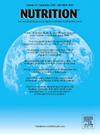Segmental phase angle and the extracellular to intracellular water ratio are associated with functional disability in community-dwelling older adults: A follow-up study of up to 12 years
IF 3.2
3区 医学
Q2 NUTRITION & DIETETICS
引用次数: 0
Abstract
Background & aims
Muscle quality, including phase angle (PhA) and extracellular to intracellular water (ECW/ICW) ratio, assessed using multi-frequency bioelectrical impedance analysis (MF-BIA) to reflect the contractile components of the muscle, muscle cell mass, and membrane condition, is associated with health outcomes. However, its association with the incidence of disabilities remains unclear. The aim of this study was to examine the association between whole-body and segmental PhA, ECW/ICW ratio, and the incidence of functional disability compared to conventional muscle mass.
Methods
A total of 858 older adults aged ≥65 years without functional disability at baseline were followed up for 12 years. Functional disabilities were identified using the database of the Japanese Long-Term Care Insurance System. Segmental muscle quality was assessed using the raw parameters of MF-BIA, including segmental PhA and the ECW/ICW resistance ratio. For comparison, the appendicular lean mass index (ALMI) and legMI were obtained using MF-BIA.
Results
Functional disability was identified in 258 (30.1%) participants. Cox regression analysis showed that poorer leg PhA and ECW/ICW resistance ratios were significantly associated with a higher incidence of functional disability in both sexes, independent of covariates. A dose-response relationship indicated a higher risk for individuals with values below the median in the spline analysis. Conventional ALMI and legMI were not significantly associated with functional disability.
Conclusions
PhA and ECW/ICW ratio, especially in the leg, is a better predictor of functional disability than muscle mass. Muscle quality by BIA may be a useful biomarker for screening for future disabilities.
在社区居住的老年人中,节段相角和细胞外与细胞内的水比与功能残疾有关:一项长达12年的随访研究
背景,目的肌肉质量,包括相角(PhA)和细胞外/细胞内水(ECW/ICW)比,使用多频生物阻抗分析(bf - bia)评估,以反映肌肉的收缩成分、肌肉细胞质量和膜状况,与健康结果相关。然而,其与残疾发生率的关系尚不清楚。本研究的目的是研究与常规肌肉质量相比,全身和节段PhA、ECW/ICW比率和功能残疾发生率之间的关系。方法对858例≥65岁无功能障碍的老年人进行为期12年的随访。使用日本长期护理保险系统的数据库确定功能性残疾。使用MF-BIA的原始参数评估节段肌肉质量,包括节段PhA和ECW/ICW阻力比。为比较阑尾瘦质量指数(ALMI)和下肢瘦质量指数(legMI),采用MF-BIA测定。结果258名(30.1%)参与者被确定为功能性残疾。Cox回归分析显示,较差的腿部PhA和ECW/ICW阻力比与两性较高的功能残疾发生率显著相关,独立于协变量。在样条分析中,剂量-反应关系表明值低于中位数的个体风险较高。常规ALMI和legMI与功能障碍无显著相关性。结论spha和ECW/ICW比值比肌肉质量更能预测功能障碍,尤其是在腿部。BIA的肌肉质量可能是筛选未来残疾的有用生物标志物。
本文章由计算机程序翻译,如有差异,请以英文原文为准。
求助全文
约1分钟内获得全文
求助全文
来源期刊

Nutrition
医学-营养学
CiteScore
7.80
自引率
2.30%
发文量
300
审稿时长
60 days
期刊介绍:
Nutrition has an open access mirror journal Nutrition: X, sharing the same aims and scope, editorial team, submission system and rigorous peer review.
Founded by Michael M. Meguid in the early 1980''s, Nutrition presents advances in nutrition research and science, informs its readers on new and advancing technologies and data in clinical nutrition practice, encourages the application of outcomes research and meta-analyses to problems in patient-related nutrition; and seeks to help clarify and set the research, policy and practice agenda for nutrition science to enhance human well-being in the years ahead.
 求助内容:
求助内容: 应助结果提醒方式:
应助结果提醒方式:


